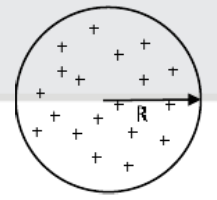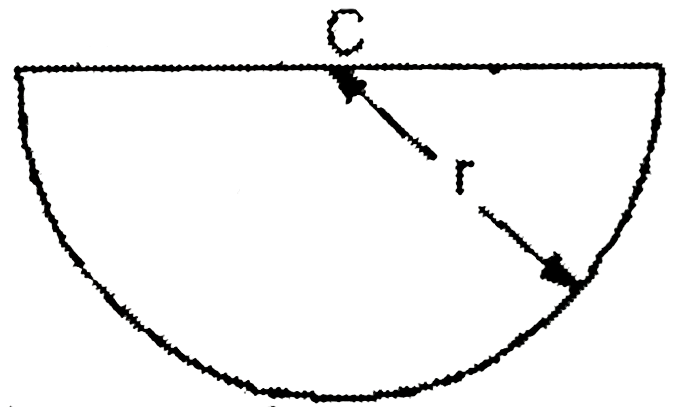The density of a circular disc is given as σ=ρ0x where 'x' is the distance from the centre. Its moment of inertia about an axis perpendicular to its plane and passing through its edge is: (A) 1516ρ0πR5 (B) 1615ρ0πR5 (C) 65ρ0πR5 (D) 56ρ0πR5
To find the moment of inertia of a circular disc with a density that varies linearly with distance from the center, we can follow these steps:
1. Understanding the Density Function:
The density of the disc is given as σ=ρ0x, where x is the distance from the center of the disc. This means that the density increases linearly from the center to the edge of the disc.
2. Consider a Differential Element:
We will consider a thin circular ring of radius x and thickness dx. The area dA of this ring is given by:
dA=2πxdx
3. Calculate the Mass of the Differential Element:
The mass dm of this thin ring can be expressed as:
dm=σdA=ρ0x⋅(2πxdx)=2πρ0x2dx
4. Moment of Inertia of the Differential Element:
The moment of inertia dI of this ring about an axis perpendicular to its plane and passing through the edge of the disc can be calculated using the parallel axis theorem:
dI=ICM+dm⋅d2
where ICM is the moment of inertia about the center of mass, and d is the distance from the center of mass to the axis through the edge (which is R for the entire disc). The moment of inertia of the ring about its own center is:
ICM=dm⋅x2
Therefore, we have:
dI=dm⋅x2+dm⋅R2=2πρ0x2dx⋅x2+2πρ0x2dx⋅R2
Simplifying, we get:
dI=2πρ0(x4+R2x2)dx
5. Integrate to Find Total Moment of Inertia:
Now we need to integrate dI from x=0 to x=R:
I=∫R0dI=∫R02πρ0(x4+R2x2)dx
This can be split into two integrals:
I=2πρ0(∫R0x4dx+R2∫R0x2dx)
6. Calculate the Integrals:
- For ∫R0x4dx=R55
- For ∫R0x2dx=R33
Substituting these results back, we have:
I=2πρ0(R55+R2⋅R33)
Simplifying further:
I=2πρ0(R55+R53)
7. Finding a Common Denominator:
The common denominator for 15 and 13 is 15:
R55=3R515,R53=5R515
Thus,
I=2πρ0(3R5+5R515)=2πρ0(8R515)=16πρ0R515
8. Final Result:
The moment of inertia about the axis perpendicular to its plane and passing through its edge is:
I=1615ρ0πR5
Conclusion:
The correct answer is (B) 1615ρ0πR5.
The density of the disc is given as σ=ρ0x, where x is the distance from the center of the disc. This means that the density increases linearly from the center to the edge of the disc.
We will consider a thin circular ring of radius x and thickness dx. The area dA of this ring is given by:
dA=2πxdx
The mass dm of this thin ring can be expressed as:
dm=σdA=ρ0x⋅(2πxdx)=2πρ0x2dx
The moment of inertia dI of this ring about an axis perpendicular to its plane and passing through the edge of the disc can be calculated using the parallel axis theorem:
dI=ICM+dm⋅d2
where ICM is the moment of inertia about the center of mass, and d is the distance from the center of mass to the axis through the edge (which is R for the entire disc). The moment of inertia of the ring about its own center is:
ICM=dm⋅x2
Therefore, we have:
dI=dm⋅x2+dm⋅R2=2πρ0x2dx⋅x2+2πρ0x2dx⋅R2
Simplifying, we get:
dI=2πρ0(x4+R2x2)dx
Now we need to integrate dI from x=0 to x=R:
I=∫R0dI=∫R02πρ0(x4+R2x2)dx
This can be split into two integrals:
I=2πρ0(∫R0x4dx+R2∫R0x2dx)
- For ∫R0x4dx=R55
- For ∫R0x2dx=R33
I=2πρ0(R55+R2⋅R33)
Simplifying further:
I=2πρ0(R55+R53)
The common denominator for 15 and 13 is 15:
R55=3R515,R53=5R515
Thus,
I=2πρ0(3R5+5R515)=2πρ0(8R515)=16πρ0R515
The moment of inertia about the axis perpendicular to its plane and passing through its edge is:
I=1615ρ0πR5
The correct answer is (B) 1615ρ0πR5.
Similar Questions
The surface density (mass/area) of a circular disc of radius a depends on the distance from the centre as ρ(r)=A+Br. Find its moment of inertia about the line perpendicular to the plane of the disc through its centre.
View SolutionThe surface density (mass/area) of a circular disc of radius a depends on the distance from the centre as ρ(r)=A+Br. Find its moment of inertia about the line perpendicular to the plane of the disc through its centre.
View SolutionCharge density of a sphere of radius R is ρ=ρ0r where r is distance from centre of sphere.Total charge of sphere will be

View SolutionA semicircular lamina of mass m and radius r and centre C. Its center of mass is at a distance x from C. Its moment of inertia about an axis through its center of mass and perpendicular to its plane is:

View SolutionA thin circular plate of mass M and radius R has its density varying as ρ(r)=ρ0r with ρ0 as constant and r is the distance from its center. The moment of Inertia of the circular plate about an axis perpendicular to the plate and passing through its edge is I=aMR2 The value of the coefficient a is :
View SolutionThe mass of a uniform circular ring of radius 0.2m is 0.1kg. Calcuate the moment of inertia of the ring about an axis passing through its centre an perpendicular to its surface.
View SolutionThe surface mass density of a disc of radius a varies with radial distance as σ=A+Br where A & B are positive constants then moment of inertia of the disc about an axis passing through its centre and perpendicular to the plane
View SolutionThe mass of a uniform circular ring of radius 0.2m is 0.1kg. Calculate the moment of inertia of the ring about an axis passing through its center and perpendicular to its surface.
View SolutionThe density of a thin rod of length l varies with the distance x from one end as ρ=ρ0x2l2. Find the position of centre of mass of rod.
View SolutionA uniform disc of radius R lies in x-y plane with its centre at origin. Its moment of inertia about the axis x=2R and y=0 is equal to the moment of inertia about the axis y=d and z=0, where d is equal to
View Solution
